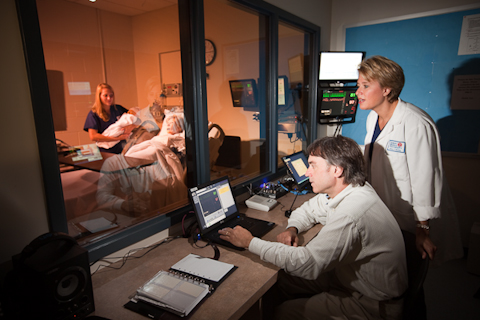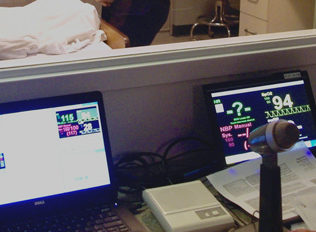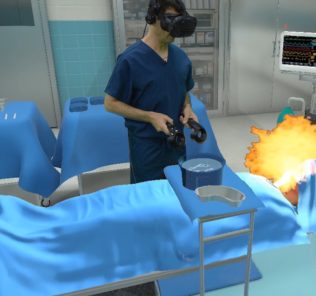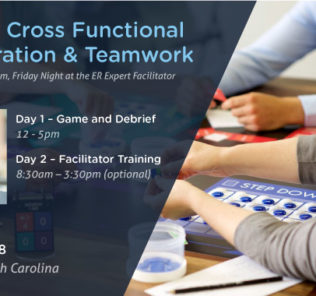One-Way Mirrors in Healthcare Simulation, Helpful or Hurtful?
Most would argue that the use of a one-way mirror enhances the “safe container” of the simulation lab space, but does it? Today guest author Molly Schleicher MSN, RN, CHSE, Simulation Educator at Robert Morris University and Educational Specialist at Oxford Medical Simulation takes a look at one-way mirrors in medical simulation asking us “Do they help us, or hurt us”?
For those of us fortunate enough to have the simulation centers with facilities to do so, educators, learners, and technicians are separated by a seemingly wonderful technology: one-way mirrors, (aka two-way mirrors or a one-way glass). For the sake of this discussion let us refer to anyone running the scenario as a “facilitator” but these people may include educators, faculty, technicians, or student workers.
One way mirrors provide learners with the ability to be “on their own” without the educator visibly peering over their shoulder. It also allows the facilitators to work diligently to run the manikin, annotate debriefing systems, act as the voice of the patient, provide guidance, and observe for evaluation — and all the while not disrupting or distracting healthcare simulation participants. It sounds like the perfect solution to already anxious participants nervous of their evaluation or being recorded. The separation enhances the “safe container” we have worked hard to create for our learners — or does it?
Sponsored Content:
For some of our learners, the magical illusion of the one way glass works. While a few students “didn’t even notice it”, for others it can have the opposite effect. Despite not being able to see the facilitators, learners can still feel like “someone is looking over your shoulder”. Some see their reflection in the glass and think of Hollywood integration scenes, making them even more anxious. However, as time goes on, most learners do seem to became more oriented with the environment, and their feareful relationship with the glass evolved.
While learners do feel like they were “being watched”, this known observation also heightens their awareness of what they were doing. Some have suggested to our faculty that they were “self-conscious, but also, more self-aware”. The common denominator in this factor seems to be time and orientation to the mechanism of the glass.
At Robert Morris University, we have overcome this obstacle by inviting learners to peer behind the glass from the very first day they are oriented in nursing simulation. During this orientation, students practice assessing the high fidelity manikins and get to hear what the different voices sound like in the room.
In addition to this personalized orientation, students are invited into the control room for a tour and to observe from the other side of the glass. This tiny step demystifies the glass that was once provoking so much anxiety. Any time during the program, learners are always offered the opportunity to observe from the control room as well, especially if the anxiety of being watched is inhibiting their ability to critically think and perform.
Sponsored Content:
What our team has learned is that the one-way mirror is required for confidentiality and creating a realistically independent clinical experience. However, like the one-way mirror itself, the most important factor to ensure psychological safety in medical simulation is transparency!
Additional Reading: “Nursing Student Anxiety in Simulation Settings: A Mixed Methods Study” by Mary Louise Cato: The use of simulation as a clinical learning activity is growing in nursing programs across the country. Using simulation, educators can provide students with a realistic patient situation using mannequins or actors as patients in a simulated environment. Students can practice multiple aspects of patient care without the risk of making mistakes with real patients, and faculty can reinforce course objectives and evaluate student learning. Because of the technology, the environment, and the methods by which simulation is implemented, it may cause anxiety in learners, which may interfere with the learning process.
Anxious students may miss an opportunity for learning valuable aspects of nursing care that are reinforced in simulation. This paper will describe a study of the student perspective on simulation, particularly related to the anxiety experienced by many learners. Nursing students in a baccalaureate program who participate in simulation in their clinical courses were recruited for the study, which consisted of a survey and a focus group. Participants were asked to rate nineteen aspects of simulation in regards to the feelings they elicit, from confidence to anxiety. The survey, completed by 73 of the 178 eligible participants, also included open-ended questions in which students could elaborate on their responses. A focus group was held after the survey, during which nine volunteer participants were asked further questions about their feelings and reactions in simulation, specifically as related to their effect on learning.
During a facilitated discussion, they also offered suggestions for interventions that they believed would decrease their anxiety and improve the learning environment in simulation. After an analysis of the data, a “comfort-stretch-panic” model (Palethorpe & Wilson, 2011) emerged as a useful framework for understanding the student perspective. Students in the “stretch” zone, in which they perceived a manageable amount of stress, were motivated to perform and experienced optimal learning from the simulation session. The student suggestions for interventions which would aid their learning may be useful for transitioning them into the “stretch” zone, and should be considered as potential tools in simulation practice.
Subscribe Today for More Great Bi-monthly Simulation Articles!
Check out Molly’s other recent article “The Evolution of Observation in Theater: What It Means for Healthcare Simulation Observers“. Have your own story to share with the global healthcare simulation community? Submit your simulation news and resources here!
Sponsored Content:

















